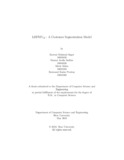LRFMVD : a customer segmentation model
Abstract
Customer segmentation is a big part of the superstore industry. Traditionally,
the RFM model has been used to segment customers to maximize profit.
This work proposes a new customer segmentation named LRFMVD based
on RFM and LRFMV models in hopes of providing a more sure-fire way of
segmenting customers. The k-means clustering method will be used for the
proposed model. The clusters created by K-means are then analyzed using
the LRFMVD model to find a correlation between profit and volume. Many
works have been done previously on customer segmentation for maximizing
profit, but none of those were able to show a straightforward representation of
profit, volume, and discounts on products. Unsupervised learning was used to
investigate the correlations between volume, discount, and profit. Customers
are then segmented using the Customer Classification Matrix, which looks
at the properties of all clusters. The L, R, F, M, VD parameters’ values are
compared to the cluster mean values, and based on whether these values are
higher or lower than the average, customers are segmented. Comparisons
among the three models reveal that the latter provides more profit per head
than the other two, and is able to identify customers who cause superstores
to lose money or make a loss.

